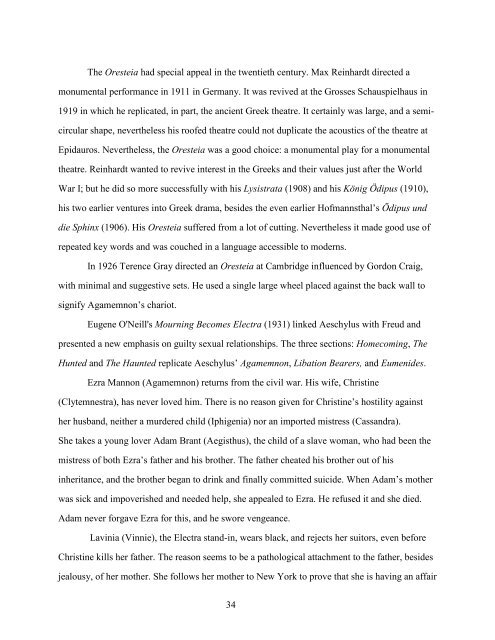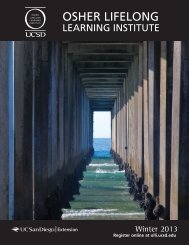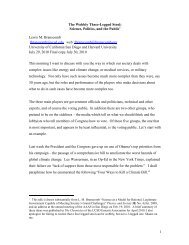1 The Living Art of Greek Tragedy Marianne McDonald, Ph.D., MRIA ...
1 The Living Art of Greek Tragedy Marianne McDonald, Ph.D., MRIA ...
1 The Living Art of Greek Tragedy Marianne McDonald, Ph.D., MRIA ...
Create successful ePaper yourself
Turn your PDF publications into a flip-book with our unique Google optimized e-Paper software.
<strong>The</strong> Oresteia had special appeal in the twentieth century. Max Reinhardt directed a<br />
monumental performance in 1911 in Germany. It was revived at the Grosses Schauspielhaus in<br />
1919 in which he replicated, in part, the ancient <strong>Greek</strong> theatre. It certainly was large, and a semi-<br />
circular shape, nevertheless his ro<strong>of</strong>ed theatre could not duplicate the acoustics <strong>of</strong> the theatre at<br />
Epidauros. Nevertheless, the Oresteia was a good choice: a monumental play for a monumental<br />
theatre. Reinhardt wanted to revive interest in the <strong>Greek</strong>s and their values just after the World<br />
War I; but he did so more successfully with his Lysistrata (1908) and his König Ödipus (1910),<br />
his two earlier ventures into <strong>Greek</strong> drama, besides the even earlier H<strong>of</strong>mannsthal’s Ödipus und<br />
die Sphinx (1906). His Oresteia suffered from a lot <strong>of</strong> cutting. Nevertheless it made good use <strong>of</strong><br />
repeated key words and was couched in a language accessible to moderns.<br />
In 1926 Terence Gray directed an Oresteia at Cambridge influenced by Gordon Craig,<br />
with minimal and suggestive sets. He used a single large wheel placed against the back wall to<br />
signify Agamemnon’s chariot.<br />
Eugene O'Neill's Mourning Becomes Electra (1931) linked Aeschylus with Freud and<br />
presented a new emphasis on guilty sexual relationships. <strong>The</strong> three sections: Homecoming, <strong>The</strong><br />
Hunted and <strong>The</strong> Haunted replicate Aeschylus’ Agamemnon, Libation Bearers, and Eumenides.<br />
Ezra Mannon (Agamemnon) returns from the civil war. His wife, Christine<br />
(Clytemnestra), has never loved him. <strong>The</strong>re is no reason given for Christine’s hostility against<br />
her husband, neither a murdered child (Iphigenia) nor an imported mistress (Cassandra).<br />
She takes a young lover Adam Brant (Aegisthus), the child <strong>of</strong> a slave woman, who had been the<br />
mistress <strong>of</strong> both Ezra’s father and his brother. <strong>The</strong> father cheated his brother out <strong>of</strong> his<br />
inheritance, and the brother began to drink and finally committed suicide. When Adam’s mother<br />
was sick and impoverished and needed help, she appealed to Ezra. He refused it and she died.<br />
Adam never forgave Ezra for this, and he swore vengeance.<br />
Lavinia (Vinnie), the Electra stand-in, wears black, and rejects her suitors, even before<br />
Christine kills her father. <strong>The</strong> reason seems to be a pathological attachment to the father, besides<br />
jealousy, <strong>of</strong> her mother. She follows her mother to New York to prove that she is having an affair<br />
34









